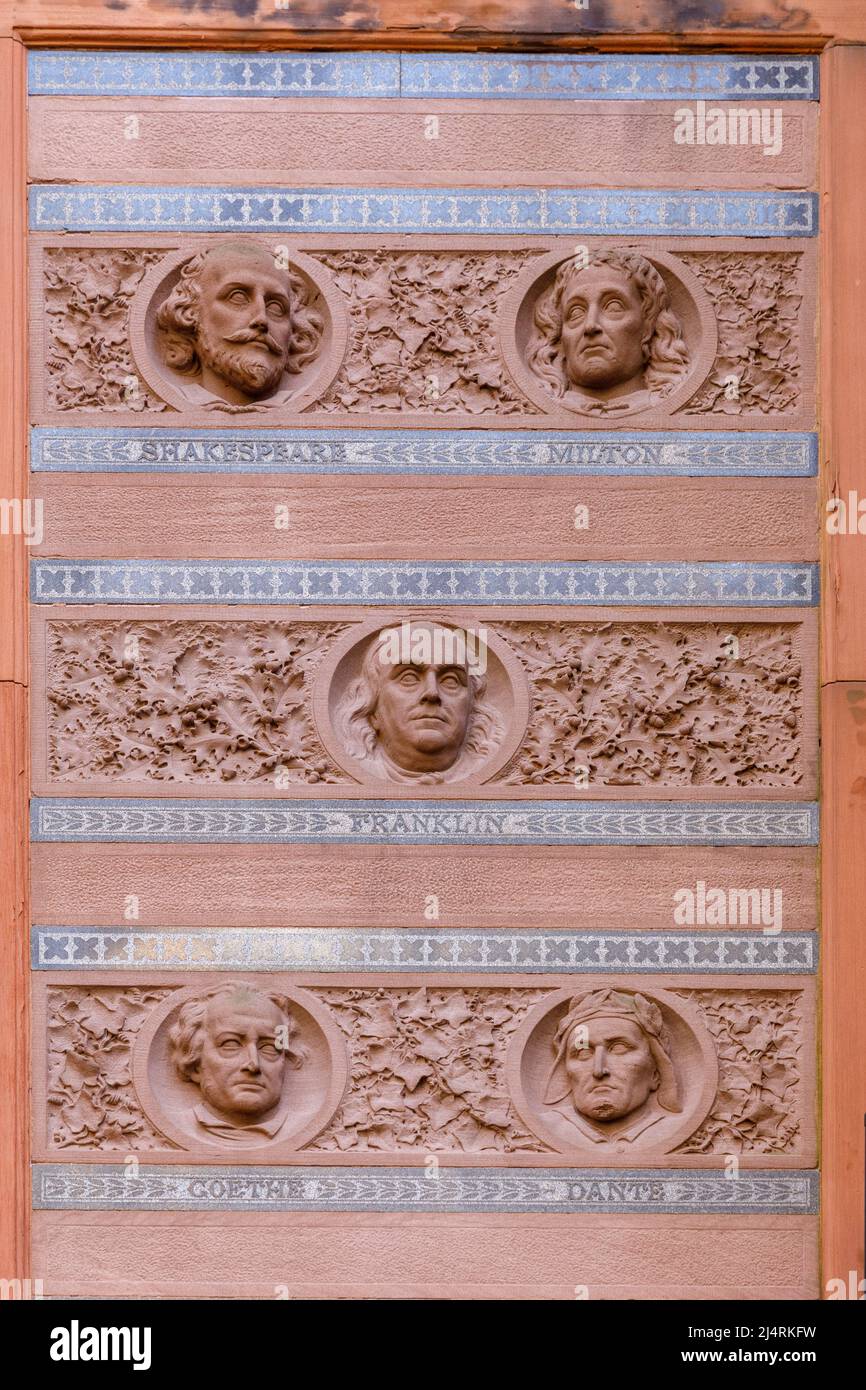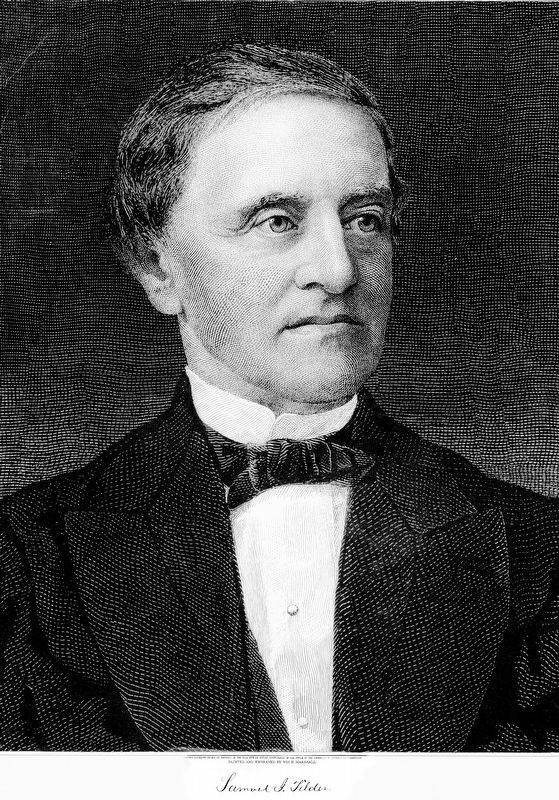
Samuel J. Tilden House, a Landmarked Victorian Gothic Revival Brownstone at 15 Gramercy Park in
The Samuel J. Tilden House is a historic townhouse pair at 14-15 Gramercy Park South in Manhattan, New York City. Built in 1845, it was the home of Samuel J. Tilden , former governor of New York, a fierce opponent of the Tweed Ring and Tammany Hall, and the losing presidential candidate in the disputed 1876 election. Tilden lived in the brownstone from 1860 until his death in 1886.

Exterior, honoring giants in Arts and Letters, National Arts Club, in the Samuel J. Tilden House
Governor Samuel J. Tilden of New York. Samuel Jones Tilden was a leading political figure of the 19th Century. He served as Governor of New York State and was the Democratic candidate for president in 1876, perhaps the most unusual presidential election in United States history. Born in 1814 in New Lebanon, NY, Tilden was educated at what later.
Samuel Jones Tilden National Portrait Gallery
United States presidential election of 1876, disputed American presidential election held on November 7, 1876, in which Republican Rutherford B. Hayes defeated Democrat Samuel J. Tilden.Tilden led Hayes by more than 260,000 popular votes, and preliminary returns showed Tilden with 184 electoral votes (one shy of the majority needed to win the election) to Hayes's 165, with the 19 electoral.

The Samuel J. Tilden House Designated a New York City land… Flickr
Issues and candidates. In 1876, Republican Rutherford B. Hayes of Ohio defeated Democrat Samuel J. Tilden of New York in the most hotly contested election to that time in the nation's history. The results initially indicated a Democratic victory, but the electoral votes of several states were ardently disputed until mere days before the new president was to be inaugurated.

Samuel Tilden PSA AutographFacts™
The Samuel J. Tilden House at 15 Gramercy Park South, where he lived from 1860 until his death is now used by the National Arts Club. Legacy. Samuel J. Tilden was an important U.S. politician during his lifetime. He held several notable offices, but he is best known for his loss to Rutherford B. Hayes in the 1876 presidential election. The.

For Find Out Friday Who Was Samuel J. Tilden?
In 1879, Samuel J. Tilden, a former governor and failed presidential candidate, rented Greystone from John Waring and bought it soon thereafter. Tilden was the first resident at Greystone to be actively interested in horticulture and during his time there built thirteen greenhouses - both for ornamental plants and for fruit and vegetables..

Flashback All the twists and turns of the election of 1876. Spoiler We came close to major
Samuel J. Tilden House. Designated a National Historic Landmark of New York City on 5/11/1976. Landmark Description Occupied today by the National Arts Club, this building was the residence (c. 1860-c. 1885) of one of the central figures in the disputed Tilden-Hayes Presidential election (1876) and resultant compromise of 1877, events which for.
/SamuelJonesTilden-58ecf3fe5f9b58f11911ec15.png)
Election of 1876 Hayes Became President
The Samuel J. Tilden House is a historic townhouse pair at 14-15 Gramercy Park South in Manhattan, New York City. Built in 1845, it was the home of Samuel J. Tilden (1814-1886), former governor of New York, a fierce opponent of the Tweed Ring and Tammany Hall, and the losing presidential candidate in the disputed 1876 election. Tilden lived.

Stairs of Samuel J. Tilden House, a Landmarked Victorian Gothic Revival Brownstone at 15
In 1876, a decade after the U.S. Civil War, Republican Rutherford B. Hayes competed against Democrat Samuel Tilden in a bitterly contested presidential election. Ultimately, Congress appointed.

Tilden Historical Marker
Samuel J. Tilden, (born Feb. 9, 1814, New Lebanon, N.Y., U.S.—died Aug. 4, 1886, Greystone, N.Y.), lawyer, governor of New York, and Democratic presidential candidate in the disputed election of 1876.. Tilden attended Yale College and the University of the City of New York for brief periods and studied law. He began to practice law in New York City in 1841.

2022 Samuel Jones Tilden American politician served as t… Flickr
Samuel J. Randall, the Democratic Speaker of the House, realizing that creating chaos would backfire on the Democrats, finally ruled the filibusterers out of order and forced the completion of the count in the early hours of March 2, 1877. With 185 votes to Tilden's 184, Hayes was declared the winner two days before he was inaugurated.

NY Samuel J. Tilden House NHL A historic townhouse pair, … Flickr
Samuel J. Tilden died the following year. From his massive estate he left $2 million to the New York Public Library and 20,000 volumes from his own library. The house remained in the Tilden estate, becoming home to the Tilden Trust for several years,

400pound bronze wreath once sat on former NYS governor’s grave. Now it’s been stolen
1876's Parallels Hold No Comfort. Eerily, we've trod this path before--124 years ago. In 1876, the Democratic candidate for president, Gov. Samuel J. Tilden of New York, was certain he won Florida.

Samuel J. Tilden House, a Landmarked Victorian Gothic Revival Brownstone at 15 Gramercy Park in
Samuel Jones Tilden (February 9, 1814 - August 4, 1886) was an American politician who served as the 25th governor of New York and was the Democratic nominee in the disputed 1876 United States presidential election.. Tilden was born in 1814 into a wealthy family in New Lebanon, New York.Attracted to politics at a young age, he became a protégé of Martin Van Buren.

The National Arts Club (Samuel J. Tilden House) 15 Gramerc… Flickr
Samuel J. Tilden was a popular national figure during the 1870s as he successfully fought against political corruption in New York and became the Democratic presidential candidate in the 1876 election.. Living with an aunt who owned a boarding house, Tilden ended up spending most of his time running her business as well as handling political.

Presidency of Samuel J. Tilden Sumner's Legacy r/Presidentialpoll
The basic outline of events after Election Day, November 7, 1876, is familiar. The Democratic candidate, Governor Samuel J. Tilden of New York, had carried a majority of the popular vote, and by the morning after the election he had 184 of the 185 electoral votes necessary for a majority.[1]